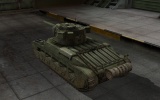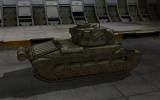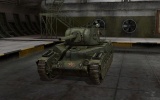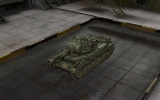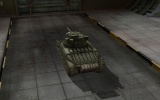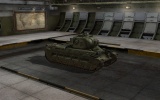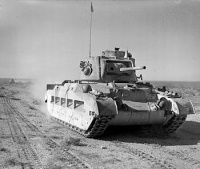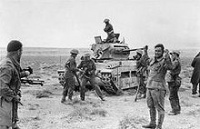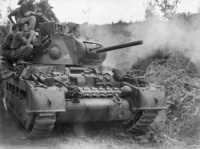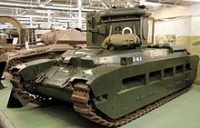Matilda IV
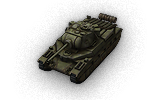
The Matilda is a British tier 5 Medium tank that was lend leased to the USSR and that can only be purchased with Gold. The Matilda was Lend-Leased to the USSR. Under this program, British and U.S. designed and built tanks were sent to Russia. Though the Matilda is classified as a Medium tank, when compared to similar-tiered vehicles it emerges about equal in terms of firepower and armor, but its low mobility lends this tank to be played more as a Heavy tank. Since it rarely sits at the top in a match, its ideal role is to play a support position and help destroy low-tier tanks; allowing your team's Heavy tanks to focus on the enemy's Heavies. Also, thanks to the high rate of fire of its gun, destroying incoming enemy scouts is fairly simple.
R32 Matilda II LL/ModulesR32 Matilda II LL/EquipmentR32 Matilda II LL/Consumables
Historical Info
When the earlier Infantry Tank Mark I (also known as "Matilda") was removed from service, the Infantry Tank Mk II simply became known as the Matilda.
Development history
The first suggestion for a larger Infantry Tank was made in 1936 with specification A12, and the contractor selected around the end of the year.[7] The Infantry Tank Mk II was designed at the Royal Arsenal, Woolwich[8], to General Staff specification A.12[1] and built by the Vulcan Foundry. The design was based on the A7[9] (which had started development in 1929) [10] rather than on the Infantry Tank Mk I, which was a two-man tank with a single machine gun for armament. When war was recognized as imminent, production of the Matilda II was ordered and that of the Matilda I curtailed. The first order was placed shortly after trials were completed with 140 orderd from the Vulcan Foundry in mid 1938.[11]
Design
The Matilda Senior[12] weighed around 27 tons (27 tons or 60,000 lb)[13], more than twice as much as its predecessor, and was armed with a QF 2 pounder (40 mm) tank gun in a three-man turret. The turret traversed by hydraulic motor or by hand through 360 degrees; the gun could be elevated through an arc from -15[nb 2] to +20 degrees.[5] One of the most serious weakness' of the Matilda II was the lack of a high explosive round for its main gun. A high explosive shell was designed for the 2 pounder, but for reasons unknown, it was never placed in production. With its heavy armor, the Matilda II was an excellent infantry support tank, but had to rely on its machine gun when operating with infantry units.[15]
Like other infantry tanks, it was heavily armored; from 20 mm at the thinnest to 78 mm (3.1 inch) at the front, much more than most contemporaries. The turret armor was 75 millimeters (3.0 in) all round,[5] the hull side armor was 65 to 70 millimeters (2.6 to 2.8 in),[nb 3] and the rear armor, covering[clarification needed] the engine, was 55 millimeters (2.2 in).[5] The frontal armor was 75 millimeters (3.0 in), although the nose plates top and bottom were thinner, but angled. The turret roof was the same thickness as the hull roof and engine deck: 20 millimeters (0.79 in).[14] The German Panzer III and Panzer IV tanks, of the same period, had 30 to 50 millimeters (1.2 to 2.0 in) thick hull armour. The shape of the nose armour was based on the US Christie design,[16] and came to a narrow point with storage lockers added on either side. The heavy armor of the Matilda's cast turret became legendary; for a time in 1940–41, the Matilda earned the nickname "Queen of the Desert", although its weaknesses made this nickname difficult to justify.[17] At the time it was designed, this armor protection was impervious to the 37 mm and 50 mm caliber anti-tank guns employed by the German forces, as well as the 47 mm used by the Italians in North Africa; only the 75 mm PAK 40 could tackle it, although having to fire at dangerously close range, as well as the scarce 88 mm anti-aircraft gun used as an anti-tank gun.
The weight of the armor, together with the relatively weak twin-engine power unit (the engine was adapted from that of a bus[18]) and complex, troublesome suspension, severely limited the speed of the vehicle. In the desert terrain of North Africa, the Matilda could average only about 6 mph (9.7 km/h). This was not thought to be a problem because the Matilda was specifically designed in accordance with the British doctrine of infantry tanks, that is, heavily-armored, but slow-moving vehicles designed to provide support to infantry; a speed equal to the walking speed of a man was considered sufficient.
Each engine had a coolant and lubrication system. The radiators were to the rear of the engine compartment over the transmission. The twin engine design doubled the maintenance effort for crews and often resulting in uneven wear and tear of components. The twin engines gave some redundancy. If one engine broke down, the tank could "limp along" on the other.[19]
The tank was carried by 5 double wheel bogies on each side. Four of the bogies were paired on a common coil spring. The fifth, rearmost bogie was sprung against a hull bracket. Between the first bogie and the idler wheel was a "jockey wheel". The first Matildas had return rollers, these were replaced in later models with track skids which were far easier to manufacture.
The turret carried the main armament with the machine gun to the right in a rotating internal mantlet. Two smoke grenade launchers were carried on the right side of the turret.[20] The grenade launcher mechanisms were cut down Lee-Enfield rifles, each firing a single smoke grenade.
Production history
The first Matilda was produced in 1937, but only two were in service when war broke out in September 1939. Following the initial order from Vulcan Foundry, a second order was placed shortly after with Ruston & Hornsby.[21] Some 2,987 tanks were produced by the Vulcan Foundry, John Fowler & Co. of Leeds, Ruston & Hornsby, and later by the London, Midland, and Scottish Railway at Horwich Works, Harland and Wolff, and the North British Locomotive Company Glasgow. The last were delivered in August 1943. Peak production was 1,330 in 1942, the most common model being the Mark IV.[22]
The Matilda was difficult to manufacture. For example, the pointed nose was a single casting that, upon initial release from the mould, was thicker than required in some areas. To avoid a needless addition to the tank's weight, the thick areas were ground away. This process required highly-skilled workers and additional time. The complex suspension and multi-piece hull side coverings also added time to manufacturing.[16]
Combat history
French Campaign of 1940
The Matilda was first used in combat by the 7th Royal Tank Regiment in France in 1940. Only 23 of the unit's tanks were Matilda IIs, the rest of the British Infantry Tanks in France were A11 Matildas.[23] Its 2-pounder gun was comparable to other tank guns in the 37 to 45 mm range. Due to the thickness of its armor, it was largely immune to the guns of the German tanks and anti-tank guns in France.[24] The famous 88 mm anti-aircraft guns were pressed into service as the only effective counter. In the counter-attack at Arras, although British Matilda IIs (and Matilda Is) were able briefly to disrupt German progress, being unsupported, their losses were high. All vehicles surviving the battles around Dunkirk were abandoned when the BEF evacuated.
North Africa 1940 to 1942
Up to early 1942, in the war in North Africa, the Matilda proved highly-effective against Italian and German tanks, although vulnerable to the larger and medium caliber anti-tank guns.
In late 1940, during Operation Compass, Matildas of the British 7th Armoured Division wreaked havoc among the Italian forces in Egypt. The Italians were equipped with L3 tankettes and M11/39 Medium tanks, neither of which had any chance against the Matildas. Italian gunners were to discover that the Matildas were impervious to a wide assortment of artillery. Matildas continued to confound the Italians as the British pushed them out of Egypt and entered Libya to take Bardia and Tobruk. Even as late as November 1941, German infantry combat reports show the impotence of ill-equipped infantry against the Matilda.[25]
Ultimately, in the rapid-maneuvering style of warfare often practiced in the open desert of North Africa, the Matilda's low speed and unreliable steering mechanism became major problems. Another problem was the lack of a high-explosive shell (the appropriate shell existed, but was not issued). When the German Afrika Korps arrived in North Africa, the 88 mm anti-aircraft gun was again pressed into service against the Matilda, causing heavy losses during Operation Battleaxe, where sixty-four Matildas were lost. The arrival of the more powerful 50mm Pak 38 anti-tank gun also provided a means for the German infantry to engage Matilda tanks at combat ranges. Nevertheless, during Operation Crusader, Matilda tanks of the 1st and 32nd Army Tank Brigades were instrumental in the breakout from Tobruk and the capture of the Axis fortress of Bardia .[26] The operation was decided by the infantry tanks, after the failure of the cruiser tank-equipped 7th Armoured Division to overcome the Axis tank forces in the open desert.[27]
As the German army received new tanks with more powerful guns, as well as more powerful anti-tank guns and ammunition, the Matilda proved less and less effective. Firing tests conducted by the Afrikakorps showed that the Matilda had become vulnerable to a number of German weapons at ordinary combat ranges .[28] Due to the "painfully small"[29] size of its turret ring - 54 inches (1.37 m) - the tank could not be up-gunned sufficiently to continue to be effective against more heavily-armored enemy tanks. It was also somewhat expensive to produce. Vickers proposed an alternative; the Valentine tank, which had the same gun and a similar level of armor protection, but on a faster and cheaper chassis derived from that of their "heavy cruiser" tank. With the arrival of the Valentine in autumn 1941, the Matilda was phased out by the British Army through attrition, with lost vehicles no longer replaced. By the time of the battle of El Alamein (October 1942), few Matildas were in service, with many having been lost during Operation Crusader, and then the Gazala battles in early summer of 1942. Around twenty-five took part in the battle as mine-clearing Matilda-Scorpion mine flail tanks.
Minor campaigns
In early 1941, a small number of Matildas were used during the East Africa Campaign at the Battle of Keren. However, the mountainous terrain of East Africa did not allow the tanks of B Squadron, 4th Royal Tank Regiment, to be as effective as the tanks of the 7th Royal Tank Regiment had been in Egypt and Libya. A few Matildas of the 7th RTR were present on Crete during the German invasion, and all of them were lost.[30]
Pacific Theatre
Matilda in combat at the Battle of Tarakan In the Pacific, Japanese forces were lacking in heavy anti-tank guns and the Matilda remained in service with several Australian regiments in the Australian 4th Armoured Brigade in the South West Pacific Area. They first saw active service in the Huon Peninsula campaign in October 1943. Matilda II tanks remained in action until the last day of the war in the Wewak, Bougainville, and Borneo campaigns, which made the Matilda the only British tank to remain in service throughout the war.[3]
Foreign use
The Red Army received 1,084 Matildas.[3] The Soviet Matildas saw action as early as the Battle of Moscow and became fairly common during 1942. Unsurprisingly, the tank was found to be too slow and unreliable. Crews often complained that snow and dirt were accumulating behind the "skirt" panels, clogging the suspension. The slowness and heavy armor made them comparable to the Red Army's KV-1 heavy tanks, but the Matilda had nowhere near the fire-power of the KV. Most Soviet Matildas were expended during 1942, but a few served on as late as 1944. The Soviets modified the tanks with the addition of sections of steel welded to the tracks to give better grip.[3]
Use of captured Matildas
Following Operation Battleaxe, a dozen Matildas left behind the Axis lines were repaired and put into service by the Germans.[31] The Matildas were well-regarded by their German users [32], although their use in battle caused confusion to both sides, despite extra-prominent German markings.[31]
Variants
- Infantry Tank Mark II Matilda II[5] --- First production model[33] armed with a Vickers machine gun.[5]
- Infantry Tank Mark II.A. Matilda II Mk II[5][33] --- Vickers machine gun replaced by Besa machine gun. The "A" denoted a change in armament.[5]
- Infantry Tank Mark II.A.* Matilda II Mk III[5][33] --- New Leyland diesel engine used in place of AEC engines.[5]
- Infantry Tank Mark II Matilda II Mk IV[33] --- With improved engines, rigid mounting and no turret lamp[34]
- Infantry Tank Mark II Matilda II Mk V[33] --- Improved gear box. Westinghouse air servo used.[34][35]
- Matilda II Close Support (CS) --- Variant with QF 3 inch (76 mm) [nb 4] howitzer firing smoke shells. These were generally issued to HQ units.[8][36]
- Baron I, II, III, IIIA --- Experimental Matilda chassis with mine flail - never used operationally.
- Matilda Scorpion I / II --- Matilda chassis with a mine flail. Used in North Africa, during and after the battle of El Alamain.[clarification needed]
- Matilda II CDL / Matilda V CDL (Canal Defence Light) --- The normal turret was replaced by a cylindrical one containing a searchlight (projected through a vertical slit) and a BESA machine gun.
Australian variants:
- Matilda Frog (25) --- Flame-thrower tank.
- Murray and Murray FT --- Flame-thrower tank.
- Matilda Tank-Dozer --- Bulldozer tank. A hydraulic operated bulldozer blade of similar design to those fitted to the American M3 s.
- Matilda Hedgehog (6) --- Officially known as the Matilda Projector, Hedgehog, No. 1 Mark I,[37] this fitted a Hedgehog 7-chambered spigot mortar in an armored box on the rear hull of several Australian Matilda tanks. The projector was elevated by hydraulics adapted from the Logan traversing mechanism used in M3 Medium tank turrets[37] and electrically fired either individually or in a salvo of six, from the 12 o'clock position.[38] The fifth tube could not be fired until the turret was traversed to 1 o'clock [38] to move the radio antenna out of the bomb's flightpath. Each bomb weighed 65 lb (29 kg) and contained 30 to 35 lb (14 to 16 kg) of high-explosive. The range was up to 400 m (440 yd). Aiming was accomplished by pointing the entire tank; the mounting had no independent traverse,[39] so accuracy was not spectacular, but adequate for the task.[38] Trials at Southport, Queensland, in May 1945 were pronounced a complete success, and the Projector would have been impressive against enemy bunkers, but the war ended before it was used operationally.[38]
Surviving tanks
Around 45 Matilda IIs survive in various degrees of preservation. The majority (around 30) are in Australia, either in museums or in private ownership. A notable collection is that of the Royal Australian Armoured Corps Memorial and Tank Museum, at Puckapunyal, Australia, which has five Matilda IIs on display. In Britain, the Imperial War Museum in London, and the Royal Armoured Corps Tank Museum in Bovington, Dorset, hold examples of the Matilda II. An Australian Matilda Tank-Dozer in running (restored) condition is also held by a private collector near Bathurst NSW. The Matilda II at Bovington is in running condition.[40]
Footnotes
- Engine models A183, on the left hand side, and engine model A184, right hand side.
- The WWII Equipment states that the gun could move through an elevation arc of -20 to +20 degrees.[14]
- The 65 mm was made up of the hull itself and the side skirt armour [14]
- The shell cartridge was 76.2 x 134R. On the Infantry Tank Mk IV, the Churchill tank, the gun was used for HE
Citations
- a b c d e Jentz, p. 11
- a b c Jentz, p. 13
- a b c d e f g h Bean, pp. 147–148
- a b "Matilda Infantry Tank". Doug's 'Heavy Metal' Gallery. Livesteammodels.co.uk. Retrieved 2010-02-15.
- a b c d e f g h i j k l m n Jentz, p. 12
- Jentz, pp. 12–13
- Fletcher p4
- a b WWII Vehicles
- "Arcane Fighting Vehicles - AFVs". Geocities.com. Archived from the original on 2009-10-28. Retrieved 2010-02-15.
- "Britain's A7 Medium Tanks - World War II Vehicles, Tanks, and Airplanes". Wwiivehicles.com. 1940-05-10. Retrieved 2010-02-15.
- Fletcher p8
- Fletcher (1994) p. 5
- WWII Vehicles citing various publications
- a b c WWII Equipment
- Hogg, Ian (1996), Tank Killing, Sidgwick & Jackson, pp. 138–139, ISBN 1-885119-40-2
- a b Fletcher (1994) p. 7
- Fletcher (1994) p. 14
- Fletcher (1994) p.6
- Fletcher p. 6
- Fletcher p. 8
- Fletcher (1994) p8
- Boyd
- Fletcher p. 10
- Sebag-Montifiore, pp. 149, 153
- The CRUSADER Project: German Combat Report
- Orpen
- Murphy Chapter 14 and 15
- CRUSADER Project: Firing Trials
- Fletcher p. 9
- Handel, Paul, Matilda Tanks at Retimo on the Island of Crete, Australian Army
- a b Tucker-Jones, Anthony (2007). Hitler's Great Panzer Heist. Pen and Sword Military. ISBN 184415548X.[page needed]
- von Mellenthin, Major-General F. W (1971). Panzer Battles: A Study of the Employment of Armor in the Second World War. First Ballantine Books Edition. ISBN 0345244400.[page needed]
- a b c d e Fletcher pp. 12–14
- a b Mark Bannerman, Robert Oehler. Modelling the Matilda Infantry tank. Osprey. p. 6.
- Fletcher, p 14
- Fletcher, p. 12
- a b Fletcher, David. Matilda Infantry Tank 1938-45 (Botley, Oxford, UK: Osprey, 2002), p.42.
- a b c d Fletcher, p.43.
- Paul Handel—Dust, Sand and Jungle, 2003 RAAC Memorial and Army Tank Museum, ISBN 1-876439-75-0.[page needed]
- "Vehicle Displays and Exhibits". RAAC Memorial and Army Tank Museum. Retrieved 15 February 2010.
References
Bean, Tim; Fowler, Will (2002). Russian Tanks of World War II Stalin’s armoured might. Ian Allen publishing. ISBN 0-71102-898-2. Fletcher, David; Sarson, Peter (1994), Matilda Infantry Tank 1938–45 (New Vanguard 8), Oxford: Osprey Publishing, ISBN 1-85532-457-1 Jentz, Thomas L. (1998). Tank Combat in North Africa: The Opening Rounds, Operations Sonnenblume, Brevity, Skorpion and Battleaxe, February 1941 - June 1941. Schiffer Publishing Ltd. ISBN 0-76430-226-4. Sebag-Montifiore, Hugh. Dunkirk: Fight to the last man. "Britain's Matilda tanks". WWII Vehicles, Tanks and Airplanes. Boyd, David (31 December 2008). "Matilda Mk II Infantry Tank (A.12)". WWII Equipment. "CRUSADER Project - German Firing Trials 19 March 1942". CRUSADER Project. "Defending Position 19 - Combat Report of Company 11, 255th Infantry Regiment, November 1941". CRUSADER Project. Murphy, W.E.. The Relief of Tobruk. Orpen, Neil. War in the Desert. Perrett, Bryan (1973). The Matilda (Armor in Action). Ian Allan. ISBN 0711004056. Fletcher, David, The Great Tank Scandal - British Armour in the Second World War, Part 1, HMSO
External links
- [Wikipedia]
- [OnWar - Matilda III]
- [Photo Gallery of Matilda Tanks] in Soviet service (rkkaww2.armchairgeneral.com)
- [PDF document] listing surviving Matilda tanks.
- [(1)] Video of Matilda II on show during Bovington Tankfest 2008
- [Popular Mechanics, March 1943, Tank Crew Rub Elbows In British Fortress] cutaway drawing of Matilda II
| Light Tanks | MS-1 • BT-2 • Tetrarch • T-26 • T-60 • BT-7 • BT-SV • LTP • M3 Light • T-127 • T-46 • T-70 • A-20 • T-50 • T-80 • Valentine II • T-50-2 • MT-25 |
| Medium Tanks | A-32 • T-28 • Matilda IV • T-34 • T-34-85 • A-43 • KV-13 • T-43 • A-44 • T-44 • Object 416 • T-54 • Object 430 II • Object 283 • T-62A • Object 140 • Object 430 |
| Heavy Tanks | Churchill III • KV • KV-1 • KV-220 • KV-220 Beta-Test • KV-1S • KV-2 • T-150 • IS • KV-3 • IS-3 • IS-6 • KV-4 • KV-5 • IS-8 • ST-I • IS-4 • IS-7 |
| Tank Destroyers | AT-1 • SU-76 • SU-85B • SU-85 • SU-85I • SU-100 • SU-100Y • SU-100M1 • SU-122-44 • SU-152 • ISU-152 • SU-101 • Object 704 • SU-122-54 • Object 263 • Object 268 |
| Self-Propelled Guns | SU-18 • SU-26 • SU-5 • SU-122A • SU-8 • S-51 • SU-14-1 • SU-14-2 • 212A • Object 261
|
